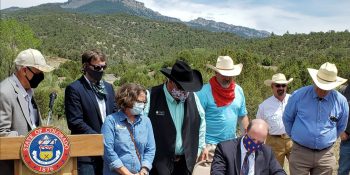TRINIDAD, Colo. – In a sun-soaked open space flanked by 9,633-foot Fishers Peak, Gov. Jared Polis signed into law Monday a bill that provides $1 million to support Colorado Parks and Wildlife’s development of Colorado’s next state park.
Polis called the funding critical toward achieving his goal of CPW opening the 19,200-acre park to the public as the 42 state park.
The governor also called the next state park an economic engine that will drive the economy of Trinidad and the region as he signed Senate Bill 3 in front of a small group of lawmakers and dignitaries including Dan Gibbs, Executive Director, Department of Natural Resources, and CPW Director Dan Prenzlow.
“This is a big day because developing our 42nd state park is not as simple as opening the gates and inviting the public,” Prenzlow said. “CPW parks staff, wildlife and aquatic biologists, engineers, wildlife managers and all our partners are deep into the process of transforming this former ranch into a showplace for all who might want to recreate here.
“CPW staff is committed to meeting the governor’s challenge to open this park by 2021 by accelerating the designing and construction of state parks from a multi-year process down to a single year. This funding will help us expedite the process. I’m confident when we finally open these gates, the public will be thrilled at the park that will greet them.”
Gibbs and Prenzlow were joined by Representatives Daneya Esgar and Perry Will, local government and business officials from Trinidad and Las Animas County as well as leaders of CPW’s non-profit partners The Nature Conservancy (TNC), The Trust for Public Land (TPL) and Great Outdoors Colorado (GOCO), each playing a critical role in the purchase of the Fishers Peak property.
“We could not have gotten this far without the hard work of our partners from GOCO, the City of Trinidad, TNC and TPL,” Prenzlow said. “Nor could this happen without our partners in the Legislature and in the hunting and fishing communities who provided millions in revenue from hunting and fishing license sales.”
In February 2019, CPW partnered with the City of Trinidad, TNC, TPL and GOCO to purchase the mostly undeveloped property, prized for its variety of habitat, wildlife and the linkage it provides between grasslands to the east with foothills and mountains to the west.
On April 2, the partners signed over ownership of the property to CPW and the agency, with its partners, immediately ramped up master-planning efforts to create a park that will protect the natural treasures and wildlife found there while welcoming visitors, including hunters, hikers, mountain bikers, wildlife watchers and other outdoor enthusiasts.
For months, biologists have been combing the property to inventory the flora and fauna. Among their discoveries was the presence of the endangered New Mexico meadow jumping mouse. In 2014, the mouse was listed as an endangered species by the U.S. Fish and Wildlife Service due to loss of habitat and low population numbers.
Bird surveys continue and are going well; biologists believe they have found a potential golden eagle nest as well as a nesting pair of peregrine falcons. They also report owl sightings.
Herptile surveys have found an unusual lizard species, a variable skink, making the property likely the only state park with this species.
Biologists have also deployed dozens of trail cameras across the property to study everything moving on the ground. There’s even coordinated weed-mapping underway with experts studying plants to formulate the appropriate seed mixture to use when landscaping areas of the park.
The information gathered will then be combined with research into the archaeological and cultural history of the property. Next comes the public process as planners gather input to set management goals for the property and design recreation areas that include roads, parking lots, restrooms, picnic areas, trails and wildlife-viewing areas for the public to enjoy.
In recent weeks, crews have begun grading and laying gravel on a new access road and parking lot.
Installing vault toilets is expected to be completed in the coming days. To stay informed on continuing progress of the park, please sign up to receive CPW eNews emails or visit cpw.state.co.us.
The property remains closed to public access.
Photos courtesy Colorado Parks and Wildlife / Bill Vogrin
SPREAD THE NEWS
COMMENT, Like, Follow & SHARE @I70Scout
CURRENT EDITION
WEATHER & TRAFFIC PUZZLES RECENT NEWS ADVERTISE WITH US






